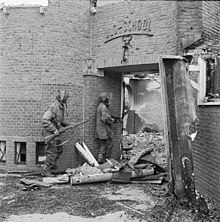Glider Pilot Regiment
| Glider Pilot Regiment | |
|---|---|
1st Viscount Alanbrooke, KG (1942-) | |
| Insignia | |
| Emblem of the British Airborne Forces |  |
The Glider Pilot Regiment was a British
Formation
The German military was one of the pioneers of the use of airborne formations, conducting several successful airborne operations during the

On 21 June 1941, the
The two officers and their newly formed unit were provided with four obsolescent

A Glider Training Squadron was formed, and the first test-flights were conducted using

There was a certain carefree atmosphere in the squadron in the first few months of its existence; new recruits were not obliged to pass a medical test to join the squadron, and it attracted a number of adventurous-minded men with a passion for flying. That one sergeant claimed to have flown a Messerschmitt during the Spanish Civil War,[12] suggested that volunteers' accounts of their past flying experience were not always subject to significant scrutiny with regard to accuracy, let alone questions of loyalty. These first pilots had been volunteers recruited from all branches of the armed forces, primarily the Army, but as the squadron began to conduct training exercises, arguments broke out between the RAF and the Army over the pilots.[13] In the view of the RAF, gliders were aircraft and therefore came under their jurisdiction and should be controlled by them; the Army argued that as the glider pilots would subsequently be fighting alongside the troops they had transported, they should come under Army control.[12] After much debate, a compromise was brokered between the two services: the pilots would be recruited from the Army but would be trained by the RAF.[12]
Volunteers were sought from the Army and had to be passed by RAF selection procedures before entering the full 11-week RAF Elementary Flying Training Course training on Tiger Moth and Miles Magister powered aircraft. Once qualified they were given further training on gliders: another 12-week course to qualify on the General Aircraft Hotspur. After a while they would then go to a Heavy Glider Conversion Unit for a six-week course so they were qualified for the Airspeed Horsa.[14]
Higher formations
In 1942 the Glider Pilot Regiment came under a newly formed administrative corps, the Army Air Corps, alongside the Parachute Regiment and wartime Special Air Service, and the air observation post squadrons of the Royal Artillery. In 1949, the AAC was broken up and the regiment formed part of the Glider Pilot and Parachute Corps. In 1957 the Glider Pilot Regiment and the air observation post squadrons of the Royal Artillery amalgamated to form the current Army Air Corps.
Regimental Association
Veterans of the regiment were represented by the Glider Pilot Regimental Association. The association published a journal entitled "The Eagle", operated a benevolent fund and organised pilgrimages to locations where the regiment had fought, particularly Normandy and Arnhem. Due to the declining number of veterans and lack of external support, the members of the association voted in favour of winding it down. It closed on 31 December 2016.
Family members of veterans, who had previously been permitted to join the association as associate members, gathered together to form a civilian society named The Glider Pilot Regiment Society which officially opened on 1 January 2017 with the approval of a large number of veterans. The objective of the society is to preserve and promote the heritage of The Glider Pilot Regiment through education and engagement and create a network for veterans of the Glider Pilot Regiment and their families to engage with one another. The society produces a magazine entitled "Glider Pilot's Notes", arranges trips for veterans and organises events every year to mark key anniversaries relating to the regiment's history.[15]
Battle honours
The regiment was awarded the following battle honours for its service during the Second World War:[16]
- Landing in Sicily
- Sicily 1943
- Normandy Landing
- Pegasus Bridge
- Merville Battery
- Southern France
- Arnhem 1944
- Rhine
- North-West Europe campaign of 1944–45
See also
- The Parachute Regiment – the UK's other airborne infantry
- Assault Glider Trust
References
Notes
- ^ Flanagan, p. 6.
- ^ Harclerode, p. 197.
- ^ Harclerode, p. 107.
- ^ Otway, p. 21
- ^ Otway, pp. 28-29
- ^ a b Smith, p. 7
- ^ Smith, pp. 7-8
- ^ a b Smith, p. 8
- ^ Smith, p. 9
- ^ Smith, pp. 9-10
- ^ Lynch, p. 31
- ^ a b c Lynch, p. 32
- ^ Smith, p.10
- ^ "Glider Pilot Regiment Society". gliderpilotregiment.
- ^ "Glider Pilot Regiment Society". Glider Pilot Regiment Society. Retrieved 25 March 2018.
- ^ "archive of regiments.org, Glider Pilot Regiment". Archived from the original on 29 October 2005. Retrieved 28 March 2013.
Bibliography
- Dank, Milton (1977). The Glider Gang: An Eyewitness History of World War II Glider Combat. Cassel. ISBN 0-304-30014-4.
- Dover, Major Victor (1981). The Sky Generals. Cassell. ISBN 0-304-30480-8.
- Flint, Keith (2006). Airborne Armour: Tetrarch, Locust, Hamilcar and the 6th Airborne Armoured Reconnaissance Regiment 1938–1950. Helion & Company Ltd. ISBN 1-874622-37-X.
- Harclerode, Peter (2005). Wings Of War – Airborne Warfare 1918–1945. Weidenfeld & Nicolson. ISBN 0-304-36730-3.
- Lloyd, Alan (1982). The Gliders: The story of Britain's fighting gliders and the men who flew them. Corgi. ISBN 0-552-12167-3.
- Lynch, Tim (2008). Silent Skies: Gliders At War 1939–1945. Barnsley: Pen & Sword Military. ISBN 9781844157365.
- Otway, Lieutenant-Colonel T.B.H. (1990). The Second World War 1939–1945 Army – Airborne Forces. Imperial War Museum. ISBN 0-901627-57-7.
- Saunders, Hilary St. George (1972). The Red Beret – The Story Of The Parachute Regiment 1940–1945. White Lion Publishers Ltd. ISBN 0-85617-823-3.
- Smith, Claude (1992). History of the Glider Pilot Regiment. Pen & Sword Aviation. ISBN 1-84415-626-5.
